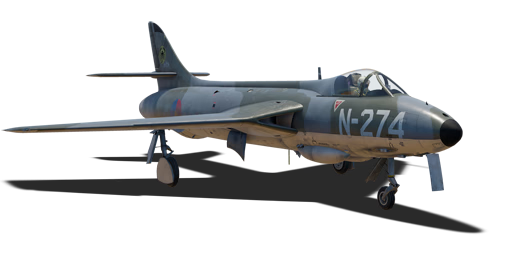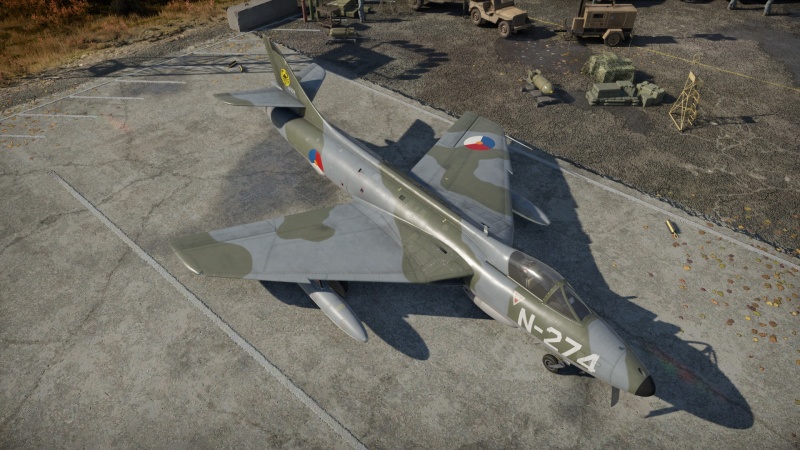Difference between revisions of "Hunter F.6 (France)"
m (Quick correction + I will not add new pictures, as I don't think they're necessary) (Tag: Visual edit) |
m (pros and cons about the guns) (Tag: Visual edit) |
||
| Line 180: | Line 180: | ||
- Sustains turns well, conserves energy | - Sustains turns well, conserves energy | ||
| − | - | + | - Good firepower |
- High speed manoeuvrability | - High speed manoeuvrability | ||
| Line 195: | Line 195: | ||
- Flareless | - Flareless | ||
| + | |||
| + | - Bullets have very low velocity | ||
| + | |||
| + | - Default belt do relatively low damage | ||
* | * | ||
Revision as of 22:25, 13 September 2024
| This page is about the Dutch jet fighter Hunter F.6 (France). For other versions, see Hunter (Family). |
Contents
Description
The ◘Hunter F.6 is a rank VI French jet fighter with a battle rating of 9.3 (AB/RB) and 9.0 (SB). It was introduced in Update "Seek & Destroy". This aircraft is quite counter-intuitive to play as a player of the usual french jets, as it behaves very differently, most notably in the aspects of combat speeds and engagement styles. With it's subpar manoeuvrability, but excellent energy retention, and cataclysmic firepower, the Dutch Hunter proposes a unique form of jet combat, based on transsonic boom & zoom, sustained turns, and shallow climb escapes.
General info
Flight performance
The Hunter F.6 is an aircraft which will feel very alien to players who are used to the other, french aircrafts present in the french tech tree. Where a Super Mystère B2 will bleed it's energy significantly, to pull G's at extreme overloads, the Hunter family is of an entirely different breed.
The Hunter excells at energy retention, being able to pull relatively hard turns, but most of all, can sustain a turn for a very long time (tens of seconds, if the scenario allows it). Energy retention and best manoeuvrability are achieved at high subsonic speeds. 800-900 km/h seems to be the standard combat sweet spot.
This superb advantage is counterbalanced by the Hunters relatively poor "on the spot" agility. The aircraft feels sluggish, it's roll rate is mediocre, and nose authority is not very impressive. This is most prevalent without the boosters installed, where reaching "overload" level G's won't be possible under 700km/h approximatively.
The engine of the Hunter F.6 goes well with the airframe it is installed on. Providing a good acceleration (higher acceleration than most first generation afterburning engines, like the General Electric J47-GE-17B found on the F-86K). This acceleration gives out at transsonic speeds, and provides the Hunter good fleeing performances if necessary. The engine gives the best performances closer to the ground, opening for possibilities of horizontal engagement, at low level.
Note : Landing the Hunter F.6 is quite difficult. With a poor airbrake that closes when the gear opens, good energy retention (playing against you, in this situation), no drogue chute, and abysmal wheel brakes, the entire runway will be used.
Small size bases are nearly always too short, and sometimes, the landscape around the longer runway doesn't allow for a clean approach. It is not uncommon to see Hunters perform gear-up landings to mitigate these problems.
| Characteristics | Max speed (km/h at 0 m - sea level) |
Max altitude (metres) |
Turn time (seconds) |
Rate of climb (metres/second) |
Take-off run (metres) | |||
|---|---|---|---|---|---|---|---|---|
| AB | RB | AB | RB | AB | RB | |||
| Stock | 1139 | 1133 | 15500 | 26.6 | 27.2 | 54.2 | 47.6 | 820 |
| Upgraded | ___ | ___ | __._ | __._ | __._ | __._ | ||
Details
| Features | |||||
|---|---|---|---|---|---|
| Combat flaps | Take-off flaps | Landing flaps | Air brakes | Arrestor gear | Drogue chute |
| _ | _ | _ | _ | _ | _ |
| Limits | ||||||
|---|---|---|---|---|---|---|
| Wings (km/h) | Gear (km/h) | Flaps (km/h) | Max Static G | |||
| Combat | Take-off | Landing | + | - | ||
| 0 | 450 | ___ | ___ | ___ | ~__ | ~__ |
| Optimal velocities (km/h) | |||
|---|---|---|---|
| Ailerons | Rudder | Elevators | Radiator |
| < ___ | < ___ | < ___ | - |
Engine performance
| Engine | Aircraft mass | |||||
|---|---|---|---|---|---|---|
| Engine name | Number | Basic mass | Wing loading (full fuel) | |||
| _____ | _ | _,___ kg | ___ kg/m2 | |||
| Engine characteristics | Mass with fuel (no weapons load) | Max Gross Weight | ||||
| Weight (each) | Type | _m fuel | __m fuel | __m fuel | ||
| ___ kg | ___ | _,___ kg | _,___ kg | _,___ kg | _,___ kg | |
| Maximum engine thrust @ 0 m (RB/SB) | Thrust to weight ratio @ 0 m (___%/WEP) | |||||
| Condition | 100% | ___%/WEP | _m fuel | __m fuel | __m fuel | MGW |
| Stationary | ___ kgf | ___ kgf | _.__ | _.__ | _.__ | _.__ |
| Optimal | ___ kgf (_ km/h) |
___ kgf (_ km/h) |
_.__ | _.__ | _.__ | _.__ |
Survivability and armour
In an era where 20-30mm autocanons reign supreme, and missiles become nearly ubiquitous, the Hunter has a very low survivability. Any hitting shot will break a wing, or cripple the engine. While the Hunter can be brought home with significant damage, allies will need to engage the pursuers and save it from danger before any return to base can be accomplished.
In light of the previous note about Hunter landings, belly landing should not be executed above 400km/h, as the risk of explosion increases drastically at higher speeds.
Modifications and economy
Once these are obtained, it is usually advised to increase engine power and streamline airflow, with associated modifications.
The missiles can be researched independantly from any other researched. The level of priority given to this modification is at the discretion of the user.
Armaments
Offensive armament
The Hunter F.6 (France) is armed with:
- 4 x 30 mm ADEN cannons, chin-mounted (150 rpg = 600 total)
The ADEN cannons cluster provide a stellar firepower for an aircraft of this size. They are installed in the nose, under the pilot, and thus are nearly perfectly centered. The stream of cannon shells from this weapon pack is nearly continuous, and the hit from only one shell is sufficient to disable even heavy fighters. Smaller agile jets like the Fiat G91 or the Mig-15 tend to explode like a grenade when impacted. by an ADEN explosive round.
The Air Targets belt tends to be the best for the aircraft, as it cannot carry air-to-ground armament, and thus is ill equipped to attack ground targets (even if they work relatively well against pillboxes and light vehicles, in an emergency situation). Stealth munitions will work as well.
Note : the weapon arrangement and firepower is similar to the Vautour II, available in the same tech tree.
Suspended armament
The only suspended armament available to the Hunter F.6 is a pair of AIM-9B Sidewinder missiles. First of their generation, these missiles are subpar at the BR, and can only be used on unsuspecting ennemies, or dogfighters whose potential energy is exhausted.
The capabilities of the missiles lend well to the Hunter F.6 playstyle, as harrassing targets increases the chances of finding them in an unfavourable position., and landing a missile shot.
The drop tanks gives an additional ten minutes of fuel. It if quasi useless for a non afterburning engine, but can be used in conjuction to a minimum internal fuel load, to ensure the fastest escape speeds by dropping them.
| Default weapon presets | |
|---|---|
| |
Usage in battles
Overall, the Hunter F.6 is an good boom & zoom airframe, and harassing multiple enemies one by one seems to yield optimal results. It is to be kept in mind that the performances of this tactic are largely dependant on the position of the Hunter in the battle. In a uptier, high overload missiles and supersonic opponents will tear the Hunter to shreds. but around it's own BR, the Hunter can engage rapidly and escape furballs, only to regengage when the next opportunity appears.
When examining placement, it can be usefull to flank the initial furballs to ensure low pressure in engagements and increased decision time. Flying at high altitudes is disadvised, as the engine power is lower and agility suffers, making the Hunter very vulnerable to missiles.
When attacking, a shallow dive angle is recommended, to avoid compressibility problems, and remain in the most manoeuvrable speed interval. This stands for escaping as well, where a 10° climb is often enough to zoom away without losing speed, and watching eventual pursuers lose theirs.
With the current opponents, it is also important to know and learns which ennemies carry potent missiles, that might extend their own defense range. Being flareless, the Hunter F.6 will not be able to defend against anything else that a R3S or AIM-9B missile.
Pros and cons
Pros:
- High acceleration
- Sustains turns well, conserves energy
- Good firepower
- High speed manoeuvrability
Cons:
- Terrible mid speed and low speed handling
- No radar
- Subpar instantaneous turn rate
- Flareless
- Bullets have very low velocity
- Default belt do relatively low damage
History
Describe the history of the creation and combat usage of the aircraft in more detail than in the introduction. If the historical reference turns out to be too long, take it to a separate article, taking a link to the article about the vehicle and adding a block "/History" (example: https://wiki.warthunder.com/(Vehicle-name)/History) and add a link to it here using the main template. Be sure to reference text and sources by using <ref></ref>, as well as adding them at the end of the article with <references />. This section may also include the vehicle's dev blog entry (if applicable) and the in-game encyclopedia description (under === In-game description ===, also if applicable).
Media
Excellent additions to the article would be video guides, screenshots from the game, and photos.
See also
- Related development
- Aircraft of comparable role, configuration, and era
External links
| Royal Dutch Aircraft Factory Fokker (Koninklijke Nederlandse Vliegtuigenfabriek Fokker) | |
|---|---|
| Strike Aircraft | ◗Fokker G.IA |
| Jet Aircraft | ▄Meteor F Mk.8* · ◘Hunter F.6* |
| Export | ▄Fokker D.XXI-3 · ▄Fokker D.XXI |
| * Licensed Production / Variants | |
| See Also | Gloster · Hawker · Valtion Lentokonetehdas |
| France jet aircraft | |
|---|---|
| Fighters | M.D.450B Ouragan · M.D.450B Barougan · M.D.452 IIA · M.D.452 IIC · Mystere IVA · Super Mystere B2 |
| ▄F-86K · ▄F-100D · ▄F-8E(FN) | |
| Mirage IIIC · Mirage IIIE · Milan · Mirage 5F · Mirage 2000C-S4 · Mirage 2000C-S5 · Mirage 2000-5F · Mirage 4000 | |
| Mirage F1C · Mirage F1C-200 · Mirage F1CT | |
| Strike aircraft | ▄F-84F · F-84F IAF · ▄F-84G-26-RE |
| Etendard IVM · Super Etendard · Alpha Jet E | |
| Jaguar A · Jaguar E · Mirage 2000D-R1 · Mirage 2000D-RMV | |
| Bombers | S.O.4050 Vautour IIA · Vautour IIA IDF/AF · S.O.4050 Vautour IIB · S.O.4050 Vautour IIN · S.O.4050 Vautour IIN (late) |
| Belgium | ▄Meteor F Mk.8 · ▄Mirage 5BA · ▄F-104G · ▄F-16A · ▄F-16AM |
| Netherlands | ◘Sea Hawk Mk.50 · ◘Hunter F.6 |





